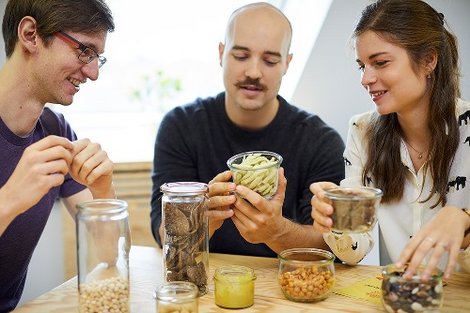“Welcome to Hülsenreich – the realm of the pulses!”

©Marco Warmuth / TGZ Halle GmbH
A start-up from Saxony-Anhalt develops healthy snacks made from peas, beans and lentils
Pulses such as chickpeas and beans are rich in vegetable proteins and fibre. They are mostly only ever used for making soup, though. With organic snacks based on pulses, however, a young start-up called “Hülsenreich” from Saxony-Anhalt is now enhancing the world of snacks with an innovative and healthy product.
There aren’t so many tasty snacks on offer with a high proportion of pulses such as beans, lentils and chickpeas – at least not in Germany. The recently established start-up business “Hülsenreich” from Saxony-Anhalt wants to close this gap; in more precise terms, the scientists from Halle (Saale) want to occupy the niche market for healthy snacks in the organic sector, as Emilie Wegner explains. The 23-year-old founder of "Hülsenreich" is optimistic that they will succeed: "A healthy diet is becoming increasingly important to more and more people. They are paying increased attention to the contents of their food. And snacks are no exception."
Traditional crisps and snacks tend to have a bad reputation because of their ingredients. With her novel snacks based on pulses, however, Emilie Wegner is arguably working with the healthiest group of plants in the world. Pulses are rich in vegetable proteins and valuable fibre. That is what gave the food scientist the idea of using pulses to create something delicious to nibble on: snacks made from chickpeas, beans, lentils and other pulses – organic, vegan and gluten-free.
That was a good two years ago. Emilie Wegner was then a student at Martin Luther University Halle-Wittenberg in Saxony-Anhalt. It was in her food blog, in which she publishes her own ideas for recipes, that she eventually came across the chickpea. At an organic shop, she ordered a ten-kilo sack of chickpea flour. "A smaller portion wasn’t available, so I had to make do with the ten kilos," she explains. The result was hearty puddings, quiches and crackers. The snacks proved to be a big hit with her friends and acquaintances. And the question quickly arose: why can’t I find these products in any of the shops?
The answer was simple: because snacks with such a high proportion of pulses were yet to have been created. It was in this way that the plan for Hülsenreich, or the “realm of the pulses”, came about. In the shape of Simon Vogt and Gunnar Schulze, Wegner found two like-minded helpers who were willing to apply their expertise in business economics and marketing to the joint start-up. "That was my personal ambition: if I manage to persuade others to join in, we’ll be able to make a go of Hülsenreich," recalls Emilie Wegner.
Holding a can of her chickpea crackers in hand, the student finally presented her idea to the start-up service at Martin Luther University Halle-Wittenberg in 2016 – and it was found to be convincing. The students were given the support that they needed to be able to establish Hülsenreich. And after graduating, they also succeeded in securing “pre-start-up funding” from the EU: Emilie Wegner and her team are currently employed as research assistants at the university. "This has enabled us to complete our project without experiencing undue pressure," she explains.
It is at the Weinberg Campus Technology Park in the city of Halle (Saale) that the trio is developing its ideas with the motto of “Willkommen im Hülsenreich!” (Welcome to the realm of the pulses). The Weinberg Campus is the location of innovation for the life sciences and materials sciences sector in the federal state of Saxony-Anhalt. Occupying a 134 hectare site, it is the second largest of its kind in eastern Germany. Since it was launched in 1993, some 200 start-ups have found the best conditions for their work here. In the food laboratory of the "Weinberg Campus Innovation Hub" for entrepreneurs and new businesses, the developers of the “Hülsenreich” snacks are able to make use of what is known as a twin-screw extruder. In this machine, under high pressure and heat, they can process the previously developed recipes into crisps, for example. "The pressure is 300 times higher than it is in a pressure cooker," explains food scientist Wegner.
One thing is clear to her: the innovative, nutrient-rich, pulses-based snacks will only have a chance to prove themselves against conventional crisp competitors if they taste good. This is another of the reasons why the founders of “Hülsenreich” are constantly working on new, tasty recipes which are based on pulses. The first development is now complete: for all fans of nibbles, and as a lighter and high-fibre alternative to salted nuts, roasted chickpeas are set to be launched on the market next year as the first “Hülsenreich" product.
The trio hopes to gain further impact due to winning this year's Hugo-Junkers Prize for Research and Innovation from the state of Saxony-Anhalt. In the special category "Food Industry" the "Hülsenreich" project convinced the jury with chickpeas. "You might think: Does snacking and nibbling really have to be healthy, sustainable and environmentally friendly? This reduces the fun while snacking, right?," asked Dr. Franziska Krüger from the Ministry of Economics in her laudation. And then she immediately gave the answer: "Hülsenreich, has awakened the rather unrecognised pulses from its deep sleep, developed a snack through the use of innovative technologies and processes that is not only healthy, but also tasty. A snack that is fun".
Black tortilla chips based on black field beans and recipes for dips such as chickpea sweet potato jalapeno or red lentil tomato chilli and white bean spinach sesame are now being developed. “We are currently experimenting with an avocado-free guacamole," explains Emilie Wegner.
Autor: Michael Falgowski
